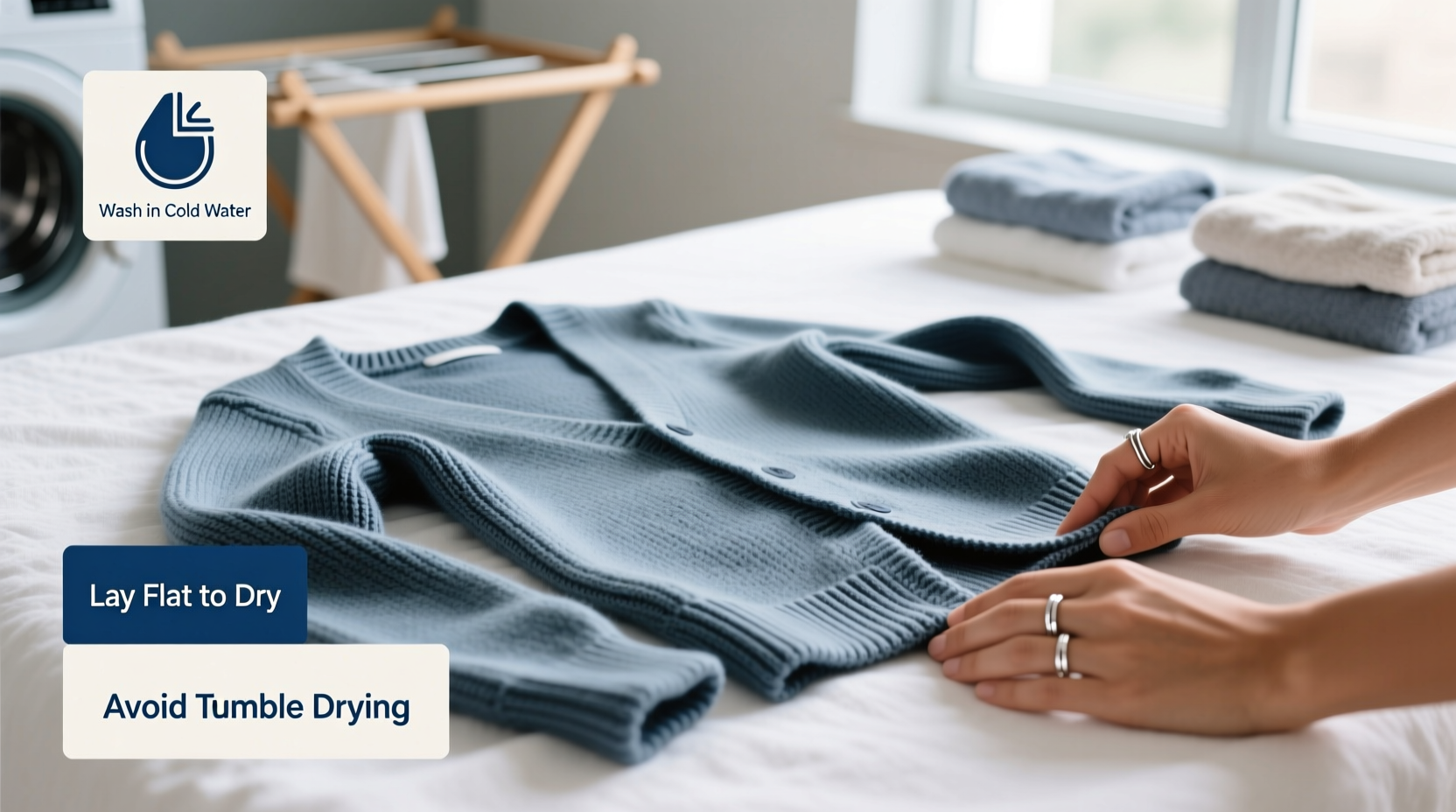Knitted cardigans are timeless wardrobe staples—soft, versatile, and effortlessly stylish. Yet, one of the most common frustrations knitters and wearers face is shrinkage after washing. A once-perfect fit can become tight across the shoulders or too short in the sleeves, rendering the garment unwearable. The good news: with proper care, you can preserve the shape, drape, and integrity of your favorite knits for years. This guide delivers expert-backed strategies to prevent shrinking and keep your cardigans looking as intended.
Understanding Why Knits Shrink

Shrinking occurs when fibers contract due to agitation, heat, or moisture. Wool, alpaca, cashmere, and even cotton—all natural fibers commonly used in cardigans—are particularly vulnerable. During manufacturing or hand-knitting, yarns are stretched and shaped. When exposed to conditions that disrupt their structure, such as hot water or mechanical tumbling, fibers tighten and pull together, causing irreversible shrinkage.
Wool is especially prone because of its scaly fiber structure. When agitated in warm water, these scales interlock (a process called felting), permanently reducing the fabric’s size. Even machine-washable wool has limits. Synthetic blends may resist shrinkage better, but they’re not immune—especially if exposed to high heat.
Step-by-Step Guide to Washing Without Shrinking
Cleaning is necessary, but doing it wrong guarantees damage. Follow this careful routine to wash your knitted cardigans safely:
- Pre-inspect the garment: Check for loose threads, stains, or weak areas. Mend any snags before washing.
- Use cold water only: Fill a clean basin with lukewarm to cold water (below 30°C / 86°F). Never use hot water.
- Add a wool-safe detergent: Use a pH-neutral, mild detergent formulated for delicates. Regular detergents strip natural oils and irritate fibers.
- Soak gently: Submerge the cardigan and press it down. Let it soak for 10–15 minutes. Do not rub, twist, or wring.
- Rinse carefully: Drain the soapy water and refill with clean cold water. Repeat rinsing until water runs clear.
- Remove excess water: Press the garment against the side of the basin to release water. Never twist or hang wet—it stretches under weight.
- Roll in a towel: Lay a clean towel flat, place the cardigan on top, roll tightly, and press to absorb moisture.
- Reshape and dry flat: Lay the cardigan on a fresh, dry towel or drying rack. Reshape to original dimensions, smoothing out sleeves and body. Avoid direct sunlight or radiators.
Drying flat is non-negotiable. Hanging a wet cardigan causes shoulder bumps and length distortion—a leading cause of perceived “shrinkage” that’s actually stretching in some areas and compression in others.
Do’s and Don’ts of Storage and Wear
How you store and wear your cardigan plays a major role in maintaining its form. Poor habits lead to sagging, misshaping, and fiber fatigue.
| Do’s | Don’ts |
|---|---|
| Fold neatly and store in a drawer or on a shelf | Hang long-term—this stretches shoulders and sleeves |
| Use breathable cotton storage bags or boxes | Store in plastic bins—traps moisture and promotes mildew |
| Rotate wear every few wears to let fibers rest | Wear daily without breaks—leads to pilling and deformation |
| Place tissue paper between folds to prevent creasing | Stack heavy items on top—compresses knit structure |
| Keep away from direct sunlight and heat sources | Leave near windows or heaters—causes fading and fiber brittleness |
Real Example: Reviving a Shrunken Cashmere Cardigan
Sarah, a knitwear enthusiast from Portland, accidentally machine-washed her favorite cashmere cardigan on warm. After drying, it was two sizes smaller. Instead of discarding it, she followed a controlled blocking method:
- She soaked the cardigan in cold water with a small amount of hair conditioner (to relax fibers).
- After draining and pressing, she laid it on a padded surface.
- Using rust-proof T-pins, she gently stretched the garment back to its original measurements, referencing an old photo.
- She allowed it to dry completely over 48 hours, re-pinning as needed.
The result? A full recovery of shape and length. While not all cases are this successful, early intervention and patience can rescue mildly shrunken knits.
“With delicate fibers like cashmere and merino, prevention is always better than repair. But if shrinkage happens quickly, there’s often time to reverse it through careful re-blocking.” — Lena Torres, Textile Conservator at The Fiber Archive
Essential Care Checklist
Keep this checklist handy for every wash and storage session:
- ✅ Read care labels—and research yarn type if unsure
- ✅ Wash only when necessary (spot clean between wears)
- ✅ Use cold water and wool-specific detergent
- ✅ Soak, don’t scrub—avoid agitation
- ✅ Dry flat on a clean surface, reshaped to original dimensions
- ✅ Store folded, never hung
- ✅ Protect from moths with cedar blocks or lavender sachets (never mothballs)
- ✅ Rotate wear to reduce stress on fibers
Frequently Asked Questions
Can I ever machine wash a knitted cardigan?
Only if the label explicitly states \"machine washable\" and you use a mesh laundry bag, cold water, and the delicate cycle. Even then, hand washing is safer. Never put knits in the dryer—ever.
What if my cardigan smells but isn’t visibly dirty?
Air it out instead. Hang it outside in the shade for a few hours or place it in a steamy bathroom while showering. Odors often dissipate without washing, preserving fiber integrity.
Is steaming safe for shaping knits?
Light steaming is acceptable for removing wrinkles, but avoid direct contact. Hold the steamer several inches away and never stretch the fabric while damp. Over-steaming can weaken fibers over time.
Conclusion: Treat Your Knits Like Heirlooms
Your knitted cardigans deserve more than casual handling—they’re investments in comfort, craftsmanship, and personal style. By understanding fiber behavior and committing to gentle, consistent care, you protect not just their shape but their emotional value. Whether handmade or store-bought, each piece tells a story. Keep that story going by folding with intention, washing with care, and storing with respect.









 浙公网安备
33010002000092号
浙公网安备
33010002000092号 浙B2-20120091-4
浙B2-20120091-4
Comments
No comments yet. Why don't you start the discussion?